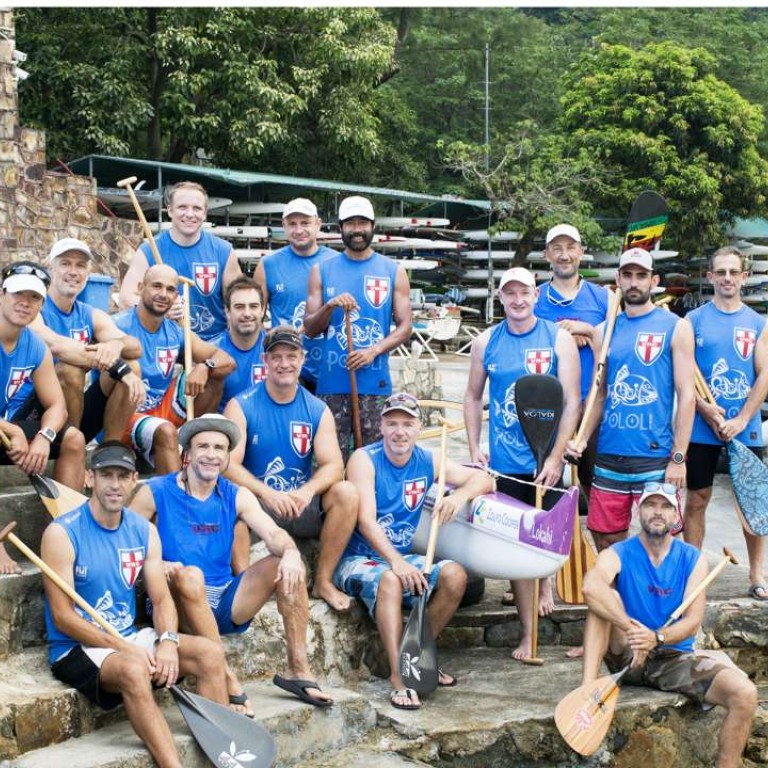
Life begins at 40 for veteran Hong Kong outrigger canoe team taking on brutal Molokai Hoe race in Hawaii
Masters squad from Victoria Recreation Club hopeful of podium finish in their category
For some of us as we hit 40, physical activity becomes limited to reaching for the remote.
But for nine members of Victoria Recreation Club in Deepwater Bay, entering middle age means a 65km paddle across one of the most dangerous stretches of water in the world, known as the “Channel of Bones” for its boat-crushing waves up to five metres high.
The club’s outrigger canoe section is sending two teams to the Molokai Hoe in Hawaii this week – the brutal race from Molokai Island to Waikiki on Oahu regarded as the sport’s world championships.
And coach Scott Dale feels his masters boat has the perfect blend of knowledge and fitness to make their mark in the 40-and-over category.
Outrigger canoes are similar to normal canoes, but with a float on one side to add stability in rough seas. They are typical of Polynesia, and some claim ancient seafarers used them to hop to America long before Columbus.
In Hong Kong, a growing contingent of fans have become converts, with clubs in Lamma, Lantau and Hong Kong Island.
“We get a lot of people from corporate dragon boat teams,” says crew member Mark Pollard, 45, who has done Molokai Hoe multiple times.
“They enjoy the camaraderie and want it more than once a year in Stanley.
“You can go stand in a hamster wheel as a gym rat or get out on the open sea and fresh air with mates and do something different.”

And there is the added incentive of a possible trip to Hawaii if you’re fit and dedicated enough.
Victoria Recreation Club’s (VRC) teams have been getting up before dawn for the past six months to train six days a week for the race.
The 15-metre-long boats have six men on board, with three in a support boat for crew rotation. The captain in the front seat sets the pace and rhythm, with technique at least as important as brute strength because catching waves and surfing is crucial.
“It’s physiology versus experience,” says architect Pollard, who has been outrigger canoeingalmost since it started in Hong Kong more than 20 years ago.
When the time came to do a business degree, he headed to the University of Hawaii, studying paddling as much as balance sheets.
“The older you get the more experience you have, but the slower you go.
"When I started paddling in Hawaii I was 32, but a legend of the sport, “Nappy” Napoleon who’s competed in every Molokai Hoe since 1958, paddled past me like he was shopping for groceries because he was surfing.
“And I still don’t think I know the ocean and conditions anything like a local, you’re always learning,” said Pollard.
Fellow crew member Andy Cummings, a 51-year-old rock climbing instructor, is also a stalwart of the Hong Kong scene, and paddles in Hawaii for six months every year.
He has also done the race several times, as part of a crew and solo.
“It’s a different race altogether on your own, you’re in it for the long haul and like a marathon you hit the wall, but you’ve got to keep going,” he says.
“You feel less up against it in the team because you’ve got your mates with you.”

Head coach Dale, 45, is a comparative newcomer.
He used to play Premiership rugby for Manly in Australia before “becoming fat and lazy” for several years as he maintained the same refuelling habits he had as an athlete without burning the calories.
“I came back to sport through paddling after coming to Hong Kong in 2008, and it’s really reignited my passion,” he says.
“In the race, you’re just a dot on the open ocean and for the first hour and a half you can’t even see land – it’s character-building, you’ve got to reach down inside yourself during the race and ask yourself some tough questions.”
The race began in 1952 with three traditional wooden boats finishing in just under nine hours. Now some 100-odd hi-tech fibreglass boats costing around US$15,000 each will aim for the current record of four and a half hours.
But it's almost impossible to replicate Hawaii's giant deep ocean swells in the waters around Hong Kong.
“Even in typhoon conditions it’s not the same, you get some rough stuff, but not in the same way,” says Cummings, before admitting almost as an afterthought: “You probably shouldn’t be out in a typhoon anyway.”
Pollard’s been involved in capsizings and seen his share of sharks, but one of his worst experiences was when a crewmate vomited all over himself.
“You don’t need a smell like that in your nostrils as you’re paddling away – luckily a wave washed it off fairly quickly.”
VRC last competed in 2014 and finished solidly in the open category even though only one of the crew was then under 40.
“It’s difficult to say where we’ll finish because we’re kind of isolated here in Asia and it’s hard to compare ourselves,” says Dale.
“But looking at historical results, I think top three in the masters is a realistic stretch target.”

